It's my understanding that a Galvanic Isolator prevents electrocution in the event that AC current escapes from the AC wiring on board (i.e. through a short in an AC battery charger), and the AC green ground wire should be bonded to the DC ground on board. It protects the hull, anodes and aluminum parts from galvanic corrosion when plugged into shore power. It is wired into the shore power grounding wire. They are two opposing semiconductor diodes. They prevent low voltage galvanic current leaving or entering the boat but easily allow 110 volts to pass through. Some may offer a monitoring panel -KCB Technologies in Canada ... if not discontinued.
The Isolation Transformer is completely different animal which completely separates the incoming AC power from the DC power on board. The AC power is transmitted electronically through the transformer. It prevents stray galvanic current from the dockside from reaching the boat, and prevents AC power from the dockside from posing a safety hazard for the crew. The AC ground wire is still connected to the DC ground to provide protection against faulty AC circuits on the boat.
By what I read, the galvanic isolator should be on any boat that plugs into shore power. It is lighter and less expensive that the transformer.
The AC and DC electrical systems are to be connected at one common grounding point.
There is a lot of easily understood info on the web about these devices, although I read where there may not be unanimous agreement where the ground wires should go. My opinion, get a qualified expert, and verify the qualifications.



